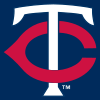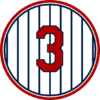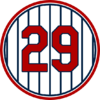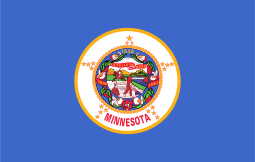Minnesota Twins
| Minnesota Twins | |||||
|---|---|---|---|---|---|
|
| |||||
| Established in 1901 | |||||
| Based in Minnesota since 1961 | |||||
| |||||
| Major league affiliations | |||||
| |||||
| Current uniform | |||||
|
| |||||
| Retired numbers | |||||
| Colors | |||||
| Name | |||||
| |||||
| Other nicknames | |||||
| |||||
| Ballpark | |||||
| Major league titles | |||||
| World Series titles (3) | |||||
| AL Pennants (6) | |||||
| Central Division titles (6) | |||||
| West Division titles (4) | |||||
| Front office | |||||
| Owner(s) | Jim Pohlad | ||||
| Manager | Paul Molitor | ||||
| General Manager | Thad Levine[3][4] | ||||
| President of Baseball Operations | Derek Falvey[5][6] | ||||
The Minnesota Twins are an American professional baseball team based in Minneapolis, Minnesota. The Twins compete in Major League Baseball (MLB) as a member club of the American League (AL) Central division. The team is named after the Twin Cities area comprising Minneapolis and St. Paul. They played in Metropolitan Stadium from 1961 to 1981 and the Hubert H. Humphrey Metrodome from 1982 to 2009. They played their inaugural game at the newly completed Target Field on April 12, 2010.[7]
The team was founded in Washington, D.C. in 1901 as one of the eight original teams of the American League, named the Washington Senators or Washington Nationals. Although the Washington team endured long bouts of mediocrity (immortalized in the 1955 Broadway musical Damn Yankees),[8] they had a period of prolonged success in the 1920s and 1930s, led by Baseball Hall of Fame members Bucky Harris, Goose Goslin, Sam Rice, Heinie Manush, Joe Cronin, and above all Walter Johnson.[9] Manager Clark Griffith joined the team in 1912 and became the team's owner in 1920.[10] The franchise remained under Griffith family ownership until 1984.[11]
In 1960, Major League Baseball granted the city of Minneapolis an expansion team. Washington owner Calvin Griffith, Clark's nephew and adopted son, requested that he be allowed to move his team to Minneapolis and instead give Washington the expansion team. Upon league approval, the team moved to Minnesota after the 1960 season, setting up shop in Metropolitan Stadium, while Washington fielded a brand new "Washington Senators" (which later became the Texas Rangers prior to the 1972 season).[12]
Success came quickly to the team in Minnesota. Sluggers Harmon Killebrew[13] and Bob Allison, who had already been stars in Washington, were joined by Tony Oliva and Zoilo Versalles, and later second baseman Rod Carew[14] and pitchers Jim Kaat and Jim Perry, winning the American League pennant in 1965.[15] A second wave of success came in the late 1980s and early 1990s under manager Tom Kelly, led by Kent Hrbek, Bert Blyleven,[16] Frank Viola, and Kirby Puckett,[17] winning the franchise's second and third World Series (and first in Minnesota).[18]
Through the 2015 season, the franchise has won three World Series championships (1924, 1987, and 1991), and has fielded 18 American League batting champions.[19][20]
Team history
Washington Nationals/Senators: 1901–1960

The Washington Senators spent the first decade of their existence finishing near the bottom of the American League standings. Their fortunes began to improve with the arrival of 19-year-old pitcher, Walter Johnson, in 1907. Johnson blossomed in 1911 with 25 victories, although the Senators still finished the season in seventh place.[21] In 1912, the Senators improved dramatically, as their pitching staff led the league in team earned run average and in strikeouts. Johnson won 33 games while teammate Bob Groom added another 24 wins to help the Senators finish the season in second place.[22] The Senators continued to perform respectably in 1913 with Johnson posting a career-high 35 victories, as the team once again finished in second place.[23] The Senators then fell into another period of decline for the next decade. After a string of mediocre seasons, a rejuvenated Johnson rebounded in 1924 to win 23 games with the help of his catcher, Muddy Ruel, as the Senators won the American League pennant for the first time in the history of the franchise.[24]
The Senators faced John McGraw's heavily favored New York Giants in the 1924 World Series.[25] The two teams traded wins back and forth until the series reached the seventh and deciding game. The Senators trailed the Giants 3 to 1 in the eighth inning of Game 7, when Bucky Harris hit a routine ground ball to third which hit a pebble and took a bad hop over Giants third baseman Freddie Lindstrom. Two runners scored on the play, tying the score at three.[26] An aging Walter Johnson then came in to pitch the ninth inning, and held the Giants scoreless into extra innings. In the bottom of the twelfth inning with Ruel at bat, he hit a high, foul ball directly over home plate.[27] The Giants' catcher, Hank Gowdy, dropped his protective mask to field the ball but, failing to toss the mask aside, stumbled over it and dropped the ball, thus giving Ruel another chance to bat.[27] On the next pitch, Ruel hit a double and proceeded to score the winning run when Earl McNeely hit a ground ball that took another bad hop over Lindstrom's head.[26][27] This would mark the only World Series triumph for the franchise during their 60-year tenure in Washington.
The following season they repeated as American League champions but ultimately lost the 1925 World Series to the Pittsburgh Pirates. After Walter Johnson's retirement in 1927, he was hired as manager of the Senators. After enduring a few losing seasons, the team returned to contention in 1930. In 1933, Senators owner Clark Griffith returned to the formula that worked for him nine years prior: 26-year-old shortstop Joe Cronin became player-manager. The Senators posted a 99–53 record and cruised to the pennant seven games ahead of the New York Yankees, but in the 1933 World Series the Giants exacted their revenge winning in five games. Following the loss, the Senators sank all the way to seventh place in 1934 and attendance began to fall. Despite the return of Harris as manager from 1935–42 and again from 1950–54, Washington was mostly a losing ball club for the next 25 years contending for the pennant only during World War II. Washington came to be known as "first in war, first in peace, and last in the American League",[28] with their hard luck being crucial to the plot of the musical and film Damn Yankees. Cecil Travis, Buddy Myer (1935 A.L. batting champion), Roy Sievers, Mickey Vernon (batting champion in 1946 and 1953), and Eddie Yost were notable Senators players whose careers were spent in obscurity due to the team's lack of success.[29][30] In 1954, the Senators signed future Hall of Fame member Harmon Killebrew. By 1959 he was the Senators’ regular third baseman and led the league with 42 home runs earning him a starting spot on the American League All-Star team.
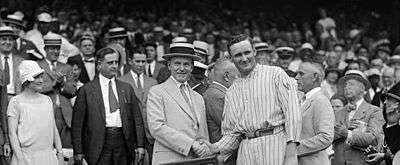
After Griffith's death in 1955, his nephew and adopted son Calvin took over the team presidency. Calvin sold Griffith Stadium to the city of Washington and leased it back leading to speculation that the team was planning to move as the Boston Braves, St. Louis Browns and Philadelphia Athletics had all done in the early 1950s. By 1957, after an early flirtation with San Francisco (where the New York Giants would eventually move after that season ended), Griffith began courting Minneapolis–St. Paul, a prolonged process that resulted in his rejecting the Twin Cities' first offer[31] before agreeing to relocate. The American League opposed the move at first, but in 1960 a deal was reached: The Senators would move and would be replaced with an expansion Senators team for 1961. Thus, the old Washington Senators became the Minnesota Twins.
Team nickname
The Washington franchise was known as both "Senators" and "Nationals" at various times, and sometimes at the same time. In 1905, the team changed its official name to the "Washington Nationals."[32] The name "Nationals" appeared on uniforms for only two seasons, and was then replaced with the "W" logo for the next 52 years. The media often shortened the nickname to "Nats." Many fans and newspapers (especially out-of-town papers) persisted in using the "Senators" nickname, because of potential confusion caused by an American League team using the "Nationals" name. Over time, "Nationals" faded as a nickname, and "Senators" became dominant. Baseball guides listed the club's nickname as "Nationals or Senators", acknowledging the dual-nickname situation.
The team name was officially changed to Washington Senators around the time of Clark Griffith's death. It was not until 1959 that the word "Senators" first appeared on team shirts. "Nats" continued to be used by space-saving headline writers, even for the 1961 expansion team, which was never officially known as "Nationals."
The current "Nationals" and "Nats" names were revived in 2005, when the Montreal Expos relocated to Washington to become the Nationals.
Minnesota Twins: 1961 to present
The name "Twins" was derived from the popular name of the region, the Twin Cities. The NBA's Minneapolis Lakers had re-located to Los Angeles in 1960 due to poor attendance which was believed to have been caused in part by the reluctance of fans in St. Paul to support the team.[33] Griffith was determined not to alienate fans in either city by naming the team after one city or the other, so his desire was to name the team the "Twin Cities Twins",[33] however MLB objected. Griffith therefore named the team the Minnesota Twins. However, the team was allowed to keep its original "TC" (for Twin Cities) insignia for its caps. The team's logo shows two men, one in a Minneapolis Millers uniform and one in a St. Paul Saints uniform, shaking hands across the Mississippi River. The "TC" remained on the Twins' caps until 1987, when they adopted their current uniforms. By this time, the team felt it was established enough to put an "M" on its cap without having St. Paul fans think it stood for Minneapolis. The "TC" logo was moved to a sleeve on the jerseys, and occasionally appeared as an alternate cap design.[34] Both the "TC" and "Minnie & Paul" logos remain the team's primary insignia. As of 2010, the "TC" logo has been reinstated on the cap as their logo.[35]
1960s
The Twins were eagerly greeted in Minnesota when they arrived in 1961. They brought a nucleus of talented players: Harmon Killebrew, Bob Allison, Camilo Pascual, Zoilo Versalles, Jim Kaat, Earl Battey, and Lenny Green. Tony Oliva, who would go on to win American League batting championships in 1964, 1965 and 1971, made his major league debut in 1962. That year, the Twins won 91 games, the most by the franchise since 1933. Behind Mudcat Grant's 21 victories, Versalles' A.L. MVP season and Oliva's batting title, the Twins won 102 games and the American League Pennant in 1965, but they were defeated in the World Series by the Los Angeles Dodgers in seven games (behind the Series MVP, Sandy Koufax, who compiled a 2–1 record, including winning the seventh game).[36]
Heading into the final weekend of the 1967 season, when Rod Carew was named the A.L. Rookie of the Year, the Twins, Boston Red Sox, Chicago White Sox, and Detroit Tigers all had a shot at clinching the American League championship. The Twins and the Red Sox started the weekend tied for 1st place and played against each other in Boston for the final three games of the season. The Red Sox won two out of the three games, seizing their first pennant since 1946 with a 92–70 record. The Twins and Tigers both finished one game back, with 91–71 records, while the White Sox finished three games back, at 89–73. In 1969, the new manager of the Twins, Billy Martin, pushed aggressive base running all-around, and Carew set the all-time Major League record by stealing home seven times in addition to winning the first of seven A.L. batting championships.[37] With Killebrew slugging 49 homers and winning the AL MVP Award, these 1969 Twins won the very first American League Western Division Championship, but they lost three straight games to the Baltimore Orioles, winners of 109 games, in the first American League Championship Series. The Orioles would go on to be upset by the New York Mets in the World Series. Martin was fired after the season following an August 1969 fight in Detroit with 20-game winner Dave Boswell and outfielder Bob Allison, in an alley outside the Lindell A.C. bar. However Bill Rigney led the Twins to a repeat division title in 1970, behind the star pitching of Jim Perry (24-12), the A.L. Cy Young Award winner, while the Orioles again won the Eastern Division Championship behind the star pitching of Jim Palmer. Once again, the Orioles won the A.L. Championship Series in a three-game sweep,[38] and this time they would win the World Series.
1970s
After winning the division again in 1970, the team entered an eight-year dry spell, finishing around the .500 mark. Killebrew departed after 1974. Owner Calvin Griffith faced financial difficulty with the start of free agency, costing the Twins the services of Lyman Bostock and Larry Hisle, who left as free agents after the 1977 season, and Carew, who was traded after the 1978 season.[39] In 1975, Carew won his fourth consecutive AL batting title,[40] having already joined Ty Cobb as the only players to lead the major leagues in batting average for three consecutive seasons. In 1977, Carew batted .388, which was the highest in baseball since Boston's Ted Williams hit .406 in 1941; he won the 1977 AL MVP Award. He won another batting title in 1978, hitting .333.[40]
1980s–90s
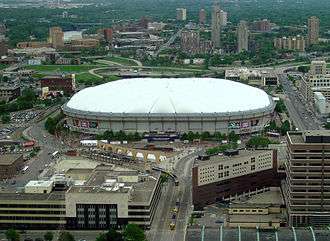
In 1982, the Twins moved into the Hubert H. Humphrey Metrodome, which they shared with the Minnesota Vikings. After a 16-54 start, the Twins were on the verge on becoming the worst team in MLB history. They turned the season around somewhat, but still lost 102 games which is the worst record in Twins history, despite the .301 average, 23 homers and 92 RBI from rookie Kent Hrbek.[41] In 1984, Griffith sold the Twins to multi-billionaire banker/financier Carl Pohlad. The Metrodome hosted the 1985 Major League Baseball All-Star Game. After several losing seasons, the 1987 team, led by Hrbek, Gary Gaetti, Frank Viola (A.L. Cy Young winner in 1988), Bert Blyleven, Jeff Reardon, Tom Brunansky, Dan Gladden, and rising star Kirby Puckett, returned to the World Series after defeating the favored Detroit Tigers in the ALCS, 4 games to 1. Tom Kelly managed the Twins to World Series victories over the St. Louis Cardinals in 1987[42][43] and the Atlanta Braves in 1991.[44] The 1988 Twins were the first team in American League history to draw more than 3 million fans.[45] Twins' pitcher and Minnesota native Jack Morris was the star of the series in 1991, going 2–0 in his three starts with a 1.17 ERA.[46] 1991 also marked the first time that any team that finished in last place in their division would advance to the World Series the following season; both the Twins and the Braves did this in 1991.[47] Contributors to the 1991 Twins' improvement from 74 wins to 95 included Chuck Knoblauch, the A.L. Rookie of the Year; Scott Erickson, 20-game winner; new closer Rick Aguilera and new designated hitter Chili Davis.
The World Series in 1991 is regarded by many as one of the classics of all time. In this Series, four games were won during the teams' final at-bat, and three of these were in extra innings. The Atlanta Braves won all three of their games in Atlanta, and the Twins won all four of their games in Minnesota. The sixth game was a legendary one for Puckett, who tripled in a run, made a sensational leaping catch against the wall, and finally in the 11th inning hit the game-winning home run. The seventh game was tied 0–0 after the regulation nine innings, and marked only the second time that the seventh game of the World Series had ever gone into extra innings. The Twins won on a walk-off RBI single by Gene Larkin in the bottom of the 10th inning, after Morris had pitched ten shutout innings against the Braves.[48] The seventh game of the 1991 World Series is widely regarded as one of the greatest games in the history of professional baseball.[49][50][51]
After a winning season in 1992 but falling short of Oakland in the division, the Twins fell into a years-long stretch of mediocrity, posting a losing record each season for the next eight: 71–91 in 1993, 50–63 in 1994, 56–88 in 1995, 78–84 in 1996, 68–94 in 1997, 70–92 in 1998, 63–97 in 1999 and 69–93 in 2000. From 1994 to 1997, a long sequence of retirements and injuries hurt the team badly, and Tom Kelly spent the remainder of his managerial career attempting to rebuild the Twins. In 1997, owner Carl Pohlad almost sold the Twins to North Carolina businessman Don Beaver, who would have moved the team to the Piedmont Triad area.[52]
Puckett after the 1995 season was forced to retire at age 35 due to loss of vision in one eye from a central retinal vein occlusion.[53] The 1989 A.L. batting champion, he retired as the Twins' all-time leader in career hits, runs, doubles, and total bases. At the time of his retirement, his .318 career batting average was the highest by any right-handed American League batter since Joe DiMaggio. Puckett was the fourth baseball player during the 20th century to record 1,000 hits in his first five full calendar years in Major League Baseball, and was the second to record 2,000 hits during his first 10 full calendar years. He was elected to the Baseball Hall of Fame in 2001, his first year of eligibility.
2000s
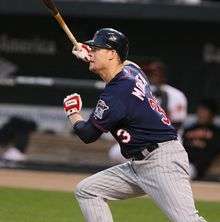
The Twins dominated the Central Division in the first decade of the new century, winning the division in six of those ten years ('02, '03, '04, '06, '09 and '10), and nearly winning it in '08 as well. From 2001 to 2006, the Twins compiled the longest streak of consecutive winning seasons since moving to Minnesota.
Threatened with closure by league contraction,[54] the 2002 team battled back to reach the American League Championship Series before being eliminated 4–1 by that year's World Series champion Anaheim Angels.
2006
In 2006, the Twins won the division on the last day of the regular season (the only day all season they held sole possession of first place) but lost to the Oakland Athletics in the ALDS. Ozzie Guillén coined a nickname for this squad, calling the Twins "little piranhas".[55] The Twins players embraced the label, and in response, the Twins Front office started a "Piranha Night", with piranha finger puppets given out to the first 10,000 fans. Scoreboard operators sometimes played an animated sequence of piranhas munching under that caption in situations where the Twins were scoring runs playing "small ball", and the stadium vendors sold T-shirts and hats advertising "The Little Piranhas".
The Twins also had the AL MVP in Justin Morneau,[56] the AL batting champion in Joe Mauer,[55] and the AL Cy Young Award winner in Johan Santana.[57]
2008
In 2008, the Twins finished the regular season tied with the White Sox on top of the AL Central, forcing a one-game playoff in Chicago to determine the division champion.[58] The Twins lost that game and missed the playoffs. The game location was determined by rule of a coin flip that was conducted in mid-September. This rule was changed for the start of the 2009 season, making the site for any tiebreaker game to be determined by the winner of the regular season head-to-head record between the teams involved.[59]
2009
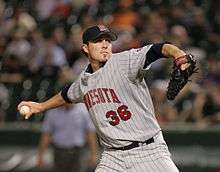
After a mediocre year where the Twins played .500 baseball for most of the season, the team won 17 of their last 21 games to tie the Detroit Tigers for the lead in the Central Division.[60] The Twins were able to use the play-in game rule to their advantage when they won the AL Central at the end of the regular season by way of a 6–5 tiebreaker game that concluded with a 12th-inning walk-off hit by Alexi Casilla.[61] However, they failed to advance to the American League Championship Series as they lost the American League Divisional Series in three straight games to the eventual World Series champion New York Yankees.[62] That year, Joe Mauer became only the second catcher in 33 years to win the AL MVP award.[63] Iván Rodríguez won for the Texas Rangers in 1999, previous to that, the last catcher to win an AL MVP was the New York Yankees Thurman Munson in 1976.[64]
2010
In their inaugural season played at Target Field, the Twins finished the regular season with a record of 94-68, clinching the AL Central Division title for the 6th time in 9 years under manager Ron Gardenhire. New regular players included rookie Danny Valencia at third base, designated hitter Jim Thome,[65] closer Matt Capps,[66] infielder J. J. Hardy,[67] and infielder Orlando Hudson.[68] In relief pitching roles were late additions Brian Fuentes and Randy Flores. On July 7, the team suffered a major blow when Justin Morneau sustained a concussion, which knocked him out for the rest of the season. In the divisional series, the Twins lost to the Yankees in a three-game sweep for the second consecutive year.[69] Following the season, Ron Gardenhire received AL Manager of the Year honors after finishing as a runner up in several prior years.[70]
2011
After repeating as AL Central champions in 2010, the Twins entered 2011 with no players on the disabled list, and the team seemed poised for another strong season. During the off-season, the team signed Japanese shortstop Tsuyoshi Nishioka to fill a hole in the middle infield, re-signed Jim Thome, who was in pursuit of career home run number 600, and also re-signed Carl Pavano. However, the season was largely derailed by an extensive list of injuries. Nishioka's broken leg in a collision at second base[71] led the way and was followed by DL stints from Kevin Slowey, Joe Mauer, Jason Repko, Thome, Delmon Young (two stints on the DL), José Mijares, Glen Perkins, Joe Nathan, Francisco Liriano, Jason Kubel, Denard Span (two stints), Justin Morneau, Scott Baker, and Alexi Casilla. The team's low point was arguably on May 1 when the team started 7 players who were batting below .235 in a game against Kansas City.[72] From that day forward, the Twins made a strong push to get as close as five games back of the division lead by the All-Star break. However, the team struggled down the stretch and fell back out of contention. The team failed to reach the playoffs for the first time since 2008 and experienced their first losing season in four years. Despite an AL-worst 63-99 record, the team drew over 3 million fans for the second consecutive year.[73]
Michael Cuddyer served as the Twins representative at the All-Star game, his first appearance.[74] Bert Blyleven's number was retired during the season and he was also inducted into the Baseball Hall of Fame during the month of July.[75] On August 10, Nathan recorded his 255th save, passing Rick Aguilera for first place on the franchise's all-time saves list.[76] On August 15, Thome hit 599th and 600th home run at Comerica Park to become the eighth player in Major League history to hit 600 home runs, joining Babe Ruth, Willie Mays, Hank Aaron, Barry Bonds, Sammy Sosa, Ken Griffey, Jr., and Alex Rodriguez.[77]
2012–2015
The team started the 2012 season with a league worst 10-24 record.[78] In late May and early June, the team embarked on a hot streak, winning ten out of thirteen games.[79][80] By mid July, the team found themselves only 10 games out of the division lead.[81] On July 16, the Twins defeated the Baltimore Orioles 19-7, the most runs scored in the short history of Target Field.[82][83] By the end of August, the Twins were more than 20 games below .500, and last in the American League.[84] On August 29, it was announced that the Twins would host the 2014 All-Star Game.[85] In 2013, the Twins finished in 4th place in the AL Central, with a record of 66-96.[86] In 2014, the team finished with a 70-92 record, last in the division and accumulated the second fewest wins in the American League.[87] As a result, Ron Gardenhire was fired on September 29, 2014.[88] On November 3, 2014 Paul Molitor was announced by the team as the 13th manager in Twins history.
In 2015, the team had a winning season (83-79), following four consecutive seasons of 90 or more losses.
Threatened contraction or relocation of the team
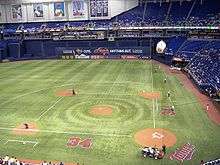
The quirks of the Hubert H. Humphrey Metrodome, including the turf floor and the white roof, gave the Twins a significant home-field advantage that played into their winning the World Series in both 1987 and 1991, at least in the opinion of their opponents, as the Twins went 12–1 in postseason home games during those two seasons.[89] These were the first two World Series in professional baseball history in which a team won the championship by winning all four home games.[90] (The feat has since been repeated once, by the Arizona Diamondbacks in 2001.) Nevertheless, the Twins argued that the Metrodome was obsolete and that the lack of a dedicated baseball-only ballpark limited team revenue and made it difficult to sustain a top-notch, competitive team (the Twins had been sharing tenancy in stadiums with the NFL's Minnesota Vikings since 1961). The team was rumored to contemplate moving to such places as New Jersey, Las Vegas, Portland, Oregon, the Greensboro/Winston-Salem, North Carolina, area, and elsewhere in search of a more financially competitive market. In 2002, the team was nearly disbanded when Major League Baseball selected the Twins and the Montreal Expos (now the Washington Nationals franchise) for elimination due to their financial weakness relative to other franchises in the league. The impetus for league contraction diminished after a court decision forced the Twins to play out their lease on the Metrodome. However, Twins owner Carl Pohlad continued his efforts to relocate, pursuing litigation against the Metropolitan Stadium Commission and obtaining a state court ruling that his team was not obligated to play in the Metrodome after the 2006 season. This cleared the way for the Twins to either be relocated or disbanded prior to the 2007 season if a new deal was not reached.
Target Field
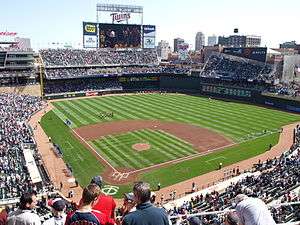
In response to the threatened loss of the Twins, the Minnesota private and public sector negotiated and approved a financing package for a replacement stadium— a baseball-only outdoor, natural turf ballpark in the Warehouse District of downtown Minneapolis— owned by a new entity known as the Minnesota Ballpark Authority.[91] Target Field was constructed at a cost of $544.4 million (including site acquisition and infrastructure), utilizing the proceeds of a $392 million public bond offering based on a 0.15% sales tax in Hennepin County and private financing of $185 million provided by the Pohlad family.[92][93] As part of the deal, the Twins also signed a 30-year lease of the new stadium, effectively guaranteeing the continuation of the team in Minnesota for a long time to come. Construction of the new field began in 2007, and was completed in December 2009, in time for the 2010 season. Commissioner Bud Selig, who earlier had threatened to disband the team, observed that without the new stadium the Twins could not have committed to sign their star player, catcher Joe Mauer, to an 8-year, $184 million contract extension. The first regular season game in Target Field was played against the Boston Red Sox on April 12, 2010, with Mauer driving in two runs and going 3-for-5 to help the Twins defeat the Red Sox, 5–2.[94]
On May 18, 2011, Target Field was named "The Best Place To Shop" by Street and Smith's SportsBusiness Journal at the magazine's 2011 Sports Business Awards Ceremony in New York City.[95] It was also named "The Best Sports Stadium in North America" by ESPN The Magazine in a ranking that included over 120 different stadiums, ballparks and arenas from around North America.[96]
In July, 2014, Target Field hosted the 85th Major League Baseball All-Star Game and the Home Run Derby.
Current roster
| Minnesota Twins 2017 spring training roster | |||||||||
|---|---|---|---|---|---|---|---|---|---|
| 40-man roster | Non-roster invitees | Coaches/Other | |||||||
|
Pitchers
|
Catchers
Infielders
Outfielders
|
Manager Coaches
| |||||||
Minnesota Twins all-time roster: A complete list of players who played in at least one game for the Twins franchise.
Minor league affiliates
Achievements
Baseball Hall of Famers
| Minnesota Twins Hall of Famers | ||||||||||||||||||
|---|---|---|---|---|---|---|---|---|---|---|---|---|---|---|---|---|---|---|
| Affiliation according to the National Baseball Hall of Fame and Museum | ||||||||||||||||||
|
Molitor and Winfield, St. Paul natives and University of Minnesota graduates,[97] came to the team late in their careers and were warmly received as "hometown heroes", but were elected to the Hall on the basis of their tenures with other teams. Both swatted their 3,000th hit with the Twins.[98][99]
Cronin, Goslin, Griffith, Harris, Johnson, Killebrew and Wynn are listed on the Washington Hall of Stars display at Nationals Park (previously they were listed at Robert F. Kennedy Stadium). So are Ossie Bluege, George Case, Joe Judge, George Selkirk, Roy Sievers, Cecil Travis, Mickey Vernon and Eddie Yost.[100]
Ford C. Frick Award recipients
| Minnesota Twins Ford C. Frick Award recipients | |||||||||
|---|---|---|---|---|---|---|---|---|---|
| Affiliation according to the National Baseball Hall of Fame and Museum | |||||||||
|
Team captains
- 3 Harmon Killebrew 1961-74
Twins Hall of Fame
| Year | Year inducted |
|---|---|
| Bold | Member of the Baseball Hall of Fame |
| |
Member of the Baseball Hall of Fame as a Twin |
| Bold | Recipient of the Hall of Fame's Ford C. Frick Award |
| Minnesota Twins Hall of Fame | ||||
| Year | No. | Name | Position(s) | Tenure |
|---|---|---|---|---|
| 2000 | 3 | Harmon Killebrew | 1B | 1961–74 |
| 29 | Rod Carew | 2B | 1967–78 | |
| 6 | Tony Oliva | RF/DH | 1962–76 | |
| 14 | Kent Hrbek | 1B | 1981–94 | |
| 34 | Kirby Puckett | CF | 1984–95 | |
| — | Calvin Griffith | President and Owner | 1961–83 | |
| 2001 | — | Herb Carneal | Radio Broadcaster | 1962–2007 |
| 36 | Jim Kaat | P | 1961–73 | |
| 2002 | 28 | Bert Blyleven | P | 1970–76 1985–88 |
| 10 | Tom Kelly | Manager | 1986–2001 | |
| 2003 | 4 | Bob Allison | OF | 1961–70 |
| — | Bob Casey | Public Address Announcer | 1961–2004 | |
| 2004 | 10 | Earl Battey | C | 1961–67 |
| 2005 | 16 | Frank Viola | P | 1982–89 |
| — | Carl Pohlad | Owner | 1984–2009 | |
| 2006 | 2 | Zoilo Versalles | SS | 1961–67 |
| 2007 | 8 | Gary Gaetti | 3B | 1981–90 |
| — | Jim Rantz | Director of Minor Leagues | 1986–2012 | |
| 2008 | 38 | Rick Aguilera | P | 1989–95 1996–99 |
| 2009[101] | 22, 23, 59 | Brad Radke | P | 1995–2006 |
| — | George Brophy | Front office executive | 1961–85 | |
| 2010[102] | 7 | Greg Gagne | SS | 1983–92 |
| 2011[103] | 31 | Jim Perry | P | 1963–72 |
| 2012[104] | 17 | Camilo Pascual | P | 1961–66 |
| 2013[105] | 18 | Eddie Guardado | P | 1993–2003, 2008 |
| — | Tom Mee | Media Relations Director | 1961-91 | |
| 2016 | — | John Gordon | Radio Broadcaster | 1987-2011 |
| 48 | Torii Hunter | CF/RF | 1997–2007, 2015 | |
Retired numbers
The Metrodome's upper deck in center and right fields was partly covered by a curtain containing banners of various titles won, and retired numbers. There was no acknowledgment of the Twins' prior championships in Washington and several Senator Hall of Famers, such as Walter Johnson, played in the days prior to numbers being used on uniforms. However Killebrew played seven seasons as a Senator, including two full seasons as a regular prior to the move to Minnesota in 1961.
Prior to the addition of the banners, the Twins acknowledged their retired numbers on the Metrodome's outfield fence. Harmon Killebrew's #3 was the first to be displayed, as it was the only one the team had retired when they moved in. It was joined by Rod Carew's #29 in 1987, Tony Oliva's #6 in 1991, Kent Hrbek's #14 in 1995, and Kirby Puckett's #34 in 1997 before the Twins began hanging the banners to reduce capacity. The championships, meanwhile were marked on the "Baggie" in right field.
|
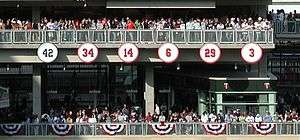
In the Metrodome, the numbers ran in that order from left to right. In Target Field, they run from right to left, presumably to allow space for additional numbers in the future. The retired numbers also serve as entry points at Target Field, The center field gate is Gate No. 3, honoring Killebrew, the left field gate is Gate No. 6, honoring Oliva, the home plate gate is Gate No. 14, for Hrbek, the right field gate serves as Gate No. 29, in tribute to Carew, and the plaza gate is known as Gate No. 34, honoring Puckett.
The numbers that have been retired hang within Target Field in front of the tower that serves as the Twins' executive offices in left field foul territory. The championships banners have been replaced by small pennants that fly on masts at the back of the left field upper deck. Those pennants, along with the flags flying in the plaza behind right field, serve as a visual cue for the players, suggesting the wind direction and speed.
Jackie Robinson's number, 42, was retired by Major League Baseball on April 15, 1997 and formally honored by the Twins on May 23, 1997.[106] Robinson's number was positioned to the left of the Twins numbers in both venues.
| Player | Jersey | Position | Date retired |
|---|---|---|---|
| Harmon Killebrew | 3 | LF-1B-3B: 1954–60 (WAS) LF-1B-3B: 1961–74 (MIN) | May 4, 1975 |
| Rod Carew | 29 | 1B-2B: 1967–78 (MIN) | July 19, 1987 |
| Tony Oliva | 6 | RF-DH: 1962–76 (MIN) Coach: 1976–78 (MIN) Coach: 1985–91 (MIN) | July 14, 1991 |
| Kent Hrbek | 14 | 1B: 1981–94 (MIN) | August 13, 1995 |
| Jackie Robinson | 42 | Retired by MLB | April 15, 1997 |
| Kirby Puckett | 34 | CF: 1984–95 (MIN) | May 25, 1997 |
| Bert Blyleven | 28 | P: 1970–76 (MIN) P: 1985–88 (MIN) | July 16, 2011 |
| Tom Kelly | 10 | Manager: 1986–2001 (MIN) | September 8, 2012 |
Awards
Team records
Team seasons
| Year | Regular Season | Postseason | Result | ||||||
|---|---|---|---|---|---|---|---|---|---|
| Wins | Losses | Win % | Finish | Attendance | Attend./Game | Record | Win % | ||
| 2001 | 85 | 77 | .525 | 2nd – AL Central | 1,782,929 | 22,011 | 0–0 | .000 | |
| 2002 | 94 | 67 | .584 | 1st – AL Central | 1,924,473 | 23,906 | 4–6 | .400 | Won ALDS vs Oakland Athletics, 3–2 Lost ALCS to Anaheim Angels, 1–4 |
| 2003 | 90 | 72 | .556 | 1st – AL Central | 1,946,011 | 24,025 | 1–3 | .250 | Lost ALDS to New York Yankees, 1–3 |
| 2004 | 92 | 70 | .568 | 1st – AL Central | 1,911,490 | 23,599 | 1–3 | .250 | Lost ALDS to New York Yankees, 1–3 |
| 2005 | 83 | 79 | .512 | 3rd – AL Central | 2,034,243 | 25,114 | 0–0 | .000 | |
| 2006 | 96 | 66 | .593 | 1st – AL Central | 2,285,018 | 28,210 | 0–3 | .000 | Lost ALDS to Oakland Athletics, 0–3 |
| 2007 | 79 | 83 | .488 | 3rd – AL Central | 2,296,347 | 28,349 | 0–0 | .000 | |
| 2008 | 88 | 75 | .540 | 2nd – AL Central | 2,302,611 | 28,427 | 0–0 | .000 | |
| 2009 | 87 | 76 | .534 | 1st – AL Central | 2,416,237 | 29,466 | 0–3 | .000 | Lost ALDS to New York Yankees, 0–3 |
| 2010 | 94 | 68 | .580 | 1st – AL Central | 3,223,640 | 39,798 | 0–3 | .000 | Lost ALDS to New York Yankees, 0–3 |
| 2011 | 63 | 99 | .389 | 5th – AL Central | 3,168,107 | 39,112 | 0–0 | .000 | |
| 2012 | 66 | 96 | .407 | 5th – AL Central | 2,776,354 | 34,275 | 0–0 | .000 | |
| 2013 | 66 | 96 | .407 | 4th – AL Central | 2,477,644 | 30,588 | 0–0 | .000 | |
| 2014 | 70 | 92 | .432 | 5th – AL Central | 2,250,606 | 27,785 | 0–0 | .000 | |
| 2015 | 83 | 79 | .521 | 2nd – AL Central | 2,220,054 | 27,408 | 0–0 | .000 | |
| 2016 | 59 | 103 | .364 | 5th – AL Central | 1,963,912 | 24,246 | 0–0 | .000 | |
| Total as Twins | 4416 | 4517 | .494 | – | – | – | 25–39 | .391 | 2 World Series Championships |
Radio and television
As of 2007, the Twins took the rights to the broadcasts in-house and created the Twins Radio Network (TRN). With that new network in place the Twins secured a new Metro Affiliate flagship radio station in KSTP. It replaced WCCO, which held broadcast rights for the Twins since the team moved to Minneapolis in 1961. For 2013, the Twins moved to FM radio on KTWN-FM 96.3 K-Twin, which is owned by the Pohlad family. The original radio voices of the Twins in 1961 were Ray Scott, Halsey Hall and Bob Wolff. After the first season, Herb Carneal replaced Wolff. Twins TV and radio broadcasts were originally sponsored by the Hamm's Brewing Company. In 2009, Treasure Island Resort & Casino became the first ever naming rights partner for the Twins Radio Network, making the commercial name of TRN the Treasure Island Baseball Network.[109]
Cory Provus is the current radio play by play announcer,[110] taking over in 2012 for longtime Twins voice John Gordon who retired following the 2011 season.[111] Former Twins OF Dan Gladden serves as color commentator.[112]
TRN broadcasts are originated from the studios at Minnesota News Network and Minnesota Farm Networks. Kris Atteberry hosts the pre-game show, the "Lineup Card" and the "Post-game Download" from those studios except when filling in for Provus or Gladden when they are on vacation.
On April 1, 2007, Herb Carneal, the radio voice of the Twins for all but one year of their existence, died at his home in Minnetonka, Minnesota after a long battle with a list of illnesses. Carneal is in the broadcasters wing of the Baseball Hall of Fame.[113]
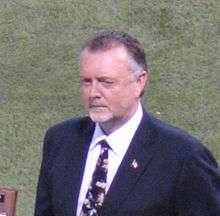
The television rights are held by Fox Sports North[114] with Dick Bremer as the play-by-play announcer and former Twin, 2011 National Baseball Hall of Fame inductee,[115] Bert Blyleven as color analyst. They are sometimes joined by Ron Coomer and Roy Smalley.[116]
Bob Casey was the Twins first public-address announcer starting in 1961 and continuing until his death in 2005. He was well known for his unique delivery and his signature announcements of "No smoking in the Metrodome, either go outside or quit!" (or "go back to Boston", etc.), "Batting 3rd, the center-fielder, No. 34, Kirby Puckett!!!" and asking fans not to 'throw anything or anybody' onto the field.[117]
Community activities
- Minnesota Twins Community Fund – Play Ball! Minnesota[118]
Team and franchise traditions
Fans wave a Homer Hanky to rally the team during play-offs and other crucial games. The Homer Hanky was created by Terrie Robbins of the Star Tribune newspaper in the Twin Cities in 1987. It was her idea to originally give away 60,000 inaugural Homer Hankies. That year, over 2.3 million Homer Hankies were distributed.[119]
The party atmosphere of the Twins clubhouse after a win is well-known,[120] the team's players unwinding with loud rock music (usually the choice of the winning pitcher) and video games.[120]
The club has several hazing rituals, such as requiring the most junior relief pitcher on the team to carry water and snacks to the bullpen in a brightly colored small child's backpack (Barbie in 2005, SpongeBob SquarePants in 2006, Hello Kitty in 2007, Disney Princess and Tinkerbell in 2009, Chewbacca and Darth Vader in 2010),[120] and many of its players, both past and present, are notorious pranksters.[120] For example, Bert Blyleven earned the nickname "The Frying Dutchman" for his ability to pull the "hotfoot" – which entails crawling under the bench in the dugout and lighting a teammate's shoelaces on fire.[121][122]
See also
References
- ↑ Bollinger, Rhett (November 10, 2014). "Twins' new home uniforms have touch of gold". Minnesota Twins. Retrieved March 31, 2015.
- ↑ "Introducing the 2015 Twins Home Uniform". Minnesota Twins. November 10, 2014. Retrieved September 1, 2015.
- ↑ Bollinger, Rhett (November 3, 2016). "Levine formally named general manager". Minnesota Twins. Retrieved November 3, 2016.
- ↑ E. Neal III, La Velle (November 3, 2016). "Twins name Thad Levine general manager". Star Tribune. Retrieved November 3, 2016.
- ↑ "Minnesota Twins name Derek Falvey Executive Vice President, Chief Baseball Officer" (Press release). Minnesota Twins. October 3, 2016. Retrieved October 4, 2016.
- ↑ E. Neal III, La Velle (October 3, 2016). "Derek Falvey officially named Twins' chief baseball officer". Star Tribune. Retrieved October 4, 2016.
- ↑ "Minnesota Twins Move Into Target Field". Minnesota Twins. January 4, 2010. Retrieved July 27, 2011.
- ↑ "Damn Yankees". The Broadway Musical Home. Retrieved August 14, 2012.
- ↑ "Johnson, Walter | Baseball Hall of Fame". Baseballhall.org. Retrieved August 14, 2012.
- ↑ "Griffith, Clark | Baseball Hall of Fame". Baseballhall.org. Retrieved August 14, 2012.
- ↑ Goldstein, Richard (October 21, 1999). "Calvin Griffith, 87, Is Dead; Tight-Fisted Baseball Owner". The New York Times.
- ↑ "Texas Rangers on Baseball Almanac". Baseball-almanac.com. Retrieved August 14, 2012.
- ↑ "Killebrew, Harmon | Baseball Hall of Fame". Baseballhall.org. Retrieved August 14, 2012.
- ↑ "Carew, Rod | Baseball Hall of Fame". Baseballhall.org. Retrieved August 14, 2012.
- ↑ "1965 Minnesota Twins Batting, Pitching, & Fielding Statistics". Baseball-Reference.com. Retrieved August 14, 2012.
- ↑ "Blyleven, Bert | Baseball Hall of Fame". Baseballhall.org. Retrieved August 14, 2012.
- ↑ "Puckett, Kirby | Baseball Hall of Fame". Baseballhall.org. Retrieved August 14, 2012.
- ↑ "Kirby Puckett & Your 1987 And 1991 World Series Championship Winning Minnesota Twins | 30-Year Old Cardboard". Bapple2286.wordpress.com. March 14, 2012. Retrieved August 14, 2012.
- ↑ "Minnesota Twins Team History & Encyclopedia". Baseball-Reference.com. Retrieved August 14, 2012.
- ↑ "Batting Average Year-by-Year Leaders / Batting Champions on Baseball Almanac". Baseball-almanac.com. Retrieved August 14, 2012.
- ↑ "1911 Washington Senators". Baseball-Reference.com. Retrieved April 30, 2012.
- ↑ "1912 Washington Senators". Baseball-Reference.com. Retrieved April 30, 2012.
- ↑ "1913 American League Team Statistics and Standings". Baseball-Reference.com. Retrieved April 30, 2012.
- ↑ "1924 American League Team Statistics and Standings". Baseball-Reference.com. Retrieved April 30, 2012.
- ↑ "1924 World Series". Baseball-Reference.com. Retrieved April 29, 2012.
- 1 2 "1924 World Series Game 7 box score". Baseball-Reference.com. Retrieved April 29, 2012.
- 1 2 3 Ruel, Muddy (October 1964). How Senators' Strategy Won for Johnson. Baseball Digest. Retrieved April 29, 2012.
- ↑ "Washington Senators". BaseballLibrary.com. Retrieved Aug 7, 2009.
- ↑ Grosshandler, Stan (February 1981). 13 Most Forgotten Stars In Major League History. Baseball Digest. Books.Google.com. Retrieved May 3, 2012.
- ↑ Vass, George (August 1999). 20th Century All-Overlooked Stars. Baseball Digest. Books.Google.com. Retrieved May 3, 2012.
- ↑ "Senators Reject Bids to Move to Minneapolis or St. Paul". New York Times. October 27, 1957. Retrieved May 2, 2008.
- ↑ "Minnesota Twins Team History & Encyclopedia". Baseball-Reference.com. Retrieved September 24, 2008.
- 1 2 "Today in Twins History". Twinstrivia.com. Retrieved August 14, 2012.
- ↑ "Twins Uniforms and Logos | twinsbaseball.com: History". Minnesota Twins. MLB. June 19, 2012. Retrieved August 14, 2012.
- ↑ "Twins Unveil New Logos, Uniforms for 2010 Season". Bizofbaseball.com. November 16, 2009. Retrieved August 14, 2012.
- ↑ "1965 World Series – Los Angeles Dodgers over Minnesota Twins (4-3)". Baseball-Reference.com. Retrieved August 14, 2012.
- ↑ Rod Carew Baseball Hall of Fame
- ↑ "1970 Minnesota Twins Batting, Pitching, & Fielding Statistics". Baseball-Reference.com. Retrieved August 14, 2012.
- ↑ "Rod Carew Statistics and History". Baseball-Reference.com. Retrieved August 14, 2012.
- 1 2 "Rod Carew Statistics". Baseball-Reference.com. Archived from the original on October 15, 2012. Retrieved August 28, 2013.
- ↑ "Kent Hrbek". Baseball-Reference.com. Archived from the original on November 10, 2012. Retrieved April 22, 2011.
- ↑ "1987 World Series by Baseball Almanac". Baseball-almanac.com. Retrieved August 14, 2012.
- ↑ "1987 World Series – Minnesota Twins over St. Louis Cardinals (4-3)". Baseball-Reference.com. Retrieved August 15, 2012.
- ↑ "1991 World Series by Baseball Almanac". Baseball-almanac.com. Retrieved August 15, 2012.
- ↑ "Twins Timeline". Minnesota Twins. Retrieved April 24, 2016.
- ↑ Caple, Jim (November 19, 2003). "1991 World Series had it all". ESPN.
- ↑ "Worst to First: Looking Back on the Miracle Season of the 1991 Atlanta Braves | Braves 101 | Sports Media 101". Braves 101. Retrieved August 15, 2012.
- ↑ "Jack Morris 1991 Game by Game Pitching Logs". Baseball-almanac.com. Retrieved August 15, 2012.
- ↑ "The top 25 single-game performances in MLB postseason history – ESPN". Espn.go.com. June 20, 2012. Retrieved August 15, 2012.
- ↑ "MLB's 20 Greatest Games | MLB Network: Network". Mlb.mlb.com. Retrieved August 15, 2012.
- ↑ Berkow, Ira (October 28, 1991). "WORLD SERIES: SPORTS OF THE TIMES; Game 7 Was a Gift From Above". The New York Times.
- ↑ Twins Meet Don Beaver: He Inks Letter of Intent to Buy Team Street & Smith's SportsBusiness Daily
- ↑ Jim Souhan (March 27, 1998). "Kirby says goodbye". StarTribune. Retrieved 2011-07-17.
- ↑ Gettings, John (2001). "Labor Pains: A guide to Major League Baseball's contraction issue". Infoplease.com. Retrieved July 27, 2011.
- 1 2 "Mauer wins AL batting title on final day – MLB – ESPN". Sports.espn.go.com. October 1, 2006. Retrieved August 15, 2012.
- ↑ "Morneau edges Jeter to win AL MVP – MLB – ESPN". Sports.espn.go.com. November 23, 2006. Retrieved August 15, 2012.
- ↑ "Johan Santana Statistics and History". Baseball-Reference.com. Retrieved August 15, 2012.
- ↑ "White Sox claim AL Central crown | whitesox.com: News". Chicago.whitesox.mlb.com. Retrieved August 15, 2012.
- ↑ "Coin flips no longer used as tiebreaker | MLB.com: News". Mlb.mlb.com. June 19, 2012. Retrieved August 15, 2012.
- ↑ "2009 Minnesota Twins Schedule, Box Scores and Splits". Baseball-Reference.com. Retrieved August 15, 2012.
- ↑ "Detroit Tigers vs. Minnesota Twins". CNN.
- ↑ "2009 Postseason | MLB.com: Schedule". Mlb.mlb.com. Retrieved August 15, 2012.
- ↑ "Mauer handily catches AL MVP Award | MLB.com: News". Minnesota Twins. MLB. Retrieved August 15, 2012.
- ↑ "Tools Of Excellence". Hartford Courant. November 24, 2009. Retrieved August 15, 2012.
- ↑ "Jim Thome, Twins – ESPN". Espn.go.com. Retrieved August 15, 2012.
- ↑ "Matt Capps – Minnesota Twins – MLB – Yahoo! Sports". Sports.yahoo.com. Retrieved August 15, 2012.
- ↑ "Milwaukee Brewers trade SS J. J. Hardy for Minnesota Twins' CF Carlos Gomez – ESPN". Sports.espn.go.com. November 6, 2009. Retrieved August 15, 2012.
- ↑ "Orlando Hudson gets one-year deal from Minnesota Twins – ESPN". Sports.espn.go.com. February 5, 2010. Retrieved August 15, 2012.
- ↑ "2010 Postseason | MLB.com: Schedule". Mlb.mlb.com. Retrieved August 15, 2012.
- ↑ "MLB Manager of the Year Award Winners". Baseball-Reference.com. Retrieved August 15, 2012.
- ↑ "Transactions | twinsbaseball.com: Team". Mlb.mlb.com. June 19, 2012. Retrieved August 16, 2012.
- ↑ "Minnesota vs. Kansas City – May 1, 2011". Sports Illustrated Canada. May 1, 2011. Retrieved August 16, 2012.
- ↑ "2012 MLB Attendance – Major League Baseball – ESPN". Espn.go.com. Retrieved August 16, 2012.
- ↑ "Michael Cuddyer a first-time All-Star at age 32 | HardballTalk". Hardballtalk.nbcsports.com. July 3, 2011. Retrieved August 16, 2012.
- ↑ Jim Caple (July 24, 2011). "Roberto Alomar, Bert Blyleven, Pat Gillick welcomed into HOF – ESPN New York". Espn.go.com. Retrieved August 16, 2012.
- ↑ "Setting Twins saves record an 'honor' for Joe Nathan | twinsbaseball.com: News". Mlb.mlb.com. June 19, 2012. Retrieved August 16, 2012.
- ↑ Duane Burleson, Associated Press. "Thome slugs home run No. 600". StarTribune.com. Retrieved August 16, 2012.
- ↑ "2012 Minnesota Twins Batting, Pitching, & Fielding Statistics". Baseball-Reference.com. Retrieved August 16, 2012.
- ↑ "Minnesota Twins vs. Seattle Mariners - Box Score - May 06, 2012 - ESPN". Scores.espn.go.com. May 6, 2012. Retrieved August 16, 2012.
- ↑ "Toronto Blue Jays vs. Minnesota Twins - Box Score - May 13, 2012 - ESPN". Scores.espn.go.com. May 13, 2012. Retrieved August 16, 2012.
- ↑ "Oakland Athletics vs. Minnesota Twins - Box Score - July 15, 2012 - ESPN". Scores.espn.go.com. July 15, 2012. Retrieved August 16, 2012.
- ↑ "Baltimore Orioles vs. Minnesota Twins - Box Score - July 16, 2012 - ESPN". Scores.espn.go.com. July 16, 2012. Retrieved August 16, 2012.
- ↑ "Span, Revere Spark Twins In 19-7 Win Over Orioles « CBS Minnesota". Minnesota.cbslocal.com. July 16, 2012. Retrieved August 16, 2012.
- ↑ "Minnesota Twins vs. Texas Rangers - Box Score - August 25, 2012 - ESPN". Scores.espn.go.com. August 25, 2012. Retrieved January 27, 2013.
- ↑ "MLB tabs Target Field for '14 All-Star Game". Major League Baseball. Retrieved April 24, 2016.
- ↑ "MLB Regular Season Standings Major League Baseball". ESPN.com. Retrieved April 24, 2016.
- ↑ "2014 MLB Regular Season Standings - Major League Baseball - ESPN". ESPN.com. Retrieved September 30, 2014.
- ↑ "Minnesota Twins fire manager Ron Gardenhire – ESPN". ESPN.com. Retrieved September 30, 2014.
- ↑ Adams, Dan (March 30, 2010). "Minnesota Twins Organization, World Series Dreams Trashed by Target Field?". Bleacher Report. Retrieved July 27, 2011.
- ↑ Gammons, Peter (2006). The 2006 ESPN Baseball Encyclopedia. New York: Sterling Pub. Co. ISBN 978-1-4027-3625-4.
- ↑ Weiner, Jay (April 1, 2010). "Target Field: 'The House That Jerry Bell Willed to Completion'". MinnPost. Retrieved July 27, 2011.
- ↑ "Editorial: Target Field built to exceed expectations". Star Tribune. May 31, 2009. Retrieved July 27, 2011.
- ↑ Gordon, Jack (March 2010). "The Coolest Ballpark in America". Twin Cities Business Magazine. Retrieved July 27, 2011.
- ↑ "April 12, 2010 Boston Red Sox at Minnesota Twins Play by Play and Box Score". Baseball-Reference.com. April 12, 2010. Retrieved August 16, 2012.
- ↑ Vomhof, Jr., John (May 19, 2011). "Target Field named Sports Facility of the Year". Minneapolis / St. Paul Business Journal. Retrieved July 27, 2011.
- ↑ Hart Van Denburg (July 2, 2010). "ESPN Magazine calls Target Field the best stadium in North America". City Pages. Retrieved July 27, 2011.
- ↑ "National Baseball Hall of Fame – The 3,000 Hit Club – Paul Molitor". Exhibits.baseballhalloffame.org. September 16, 1996. Retrieved August 16, 2012.
- ↑ "Mr. Longevity". CNN. September 27, 1993.
- ↑ "Paul Molitor 3,000th Hit Box Score (Enhanced) by Baseball Almanac". Baseball-almanac.com. September 16, 1996. Retrieved August 16, 2012.
- ↑ "Washington Senators Hall of Fame?". Baseball-fever.com. November 27, 2010. Retrieved August 16, 2012.
- ↑ Thesier, Kelly (Jan 23, 2009). "Radke, Brophy join Twins Hall of Fame". Minnesota Twins. Retrieved Jan 25, 2009.
- ↑ Thesier, Kelly (February 9, 2010). "Gagne elected to Twins Hall of Fame". Minnesota Twins. Retrieved Jul 17, 2010.
- ↑ Thesier, Kelly (January 25, 2011). "Twins great Perry gains entrance to club's Hall". Minnesota Twins. Retrieved Jan 25, 2011.
- ↑ Bollinger, Rhett (January 25, 2012). "Pascual elected to Twins Hall of Fame". Minnesota Twins. Retrieved May 18, 2012.
- ↑ "Minnesota Twins Hall of Fame adds Eddie Guardado, Tom Mee". Minnesota Twins. January 25, 2013. Retrieved January 28, 2013.
- ↑ "Minnesota Sports Almanac". Retrieved April 24, 2016.
- ↑ "Retired Uniform Numbers in the American League by Baseball Almanac". Retrieved April 24, 2016.
- ↑ "Retired Numbers". Minnesota Twins. Retrieved April 24, 2016.
- ↑ "Twins Radio Network | twinsbaseball.com: Schedule". Minnesota Twins. MLB. June 19, 2012. Retrieved August 16, 2012.
- ↑ Haudricourt, Tom. "Twins hire Provus, Gladden returns as analyst". JSOnline. Retrieved August 16, 2012.
- ↑ "Twins radio play-by-play man John Gordon will retire after season | MLB.com: News". Minnesota Twins. MLB. June 19, 2012. Retrieved August 16, 2012.
- ↑ "Twins hire Cory Provus for radio play-by-play/analyst position | twinsbaseball.com: News". Minnesota Twins. MLB. June 19, 2012. Retrieved August 16, 2012.
- ↑ "Twins Hall of Fame broadcaster dies of heart failure – MLB – ESPN". Sports.espn.go.com. April 1, 2007. Retrieved August 16, 2012.
- ↑ "FS-North, Twins announce TV schedule". Foxsportsnorth.com. February 16, 2011. Retrieved August 16, 2012.
- ↑ "Blyleven, Bert | Baseball Hall of Fame". Baseballhall.org. April 6, 1951. Retrieved August 14, 2012.
- ↑ "Minnesota Twins News, Photos and Video". FOXSportsNorth.com. Retrieved August 16, 2012.
- ↑ "Twins announcer Casey dies at age 79 | twinsbaseball.com: News". Minnesota Twins. MLB. June 19, 2012. Retrieved August 16, 2012.
- ↑ "Home page". Play Ball! Minnesota. Minnesota Twins Community Fund. Retrieved November 3, 2011.
- ↑ "McGuire on Media » Remembering the Homer Hanky, the Twins and the Star Tribune". Cronkite.asu.edu. Retrieved August 16, 2012.
- 1 2 3 4 "Twins Auction: Grounds Crew for a Day". Fox Sports North. Retrieved July 27, 2011.
- ↑ Kepner, Tyler (January 6, 2011). "Bert Blyleven Is the Hall of Fame's Merry Prankster". The New York Times.
- ↑ "Bert Blyleven Quotes". Baseball-almanac.com. Retrieved August 16, 2012.
Further reading
- Povich, Shirley (1954). The Washington Senators. New York: Putnam.
External links
| Wikimedia Commons has media related to Washington Senators (1901–1960). |
| Wikimedia Commons has media related to Minnesota Twins. |
